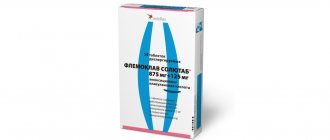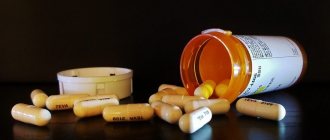Many diseases caused by bacilli require treatment with antibiotics. Since their discovery, antibiotics have saved millions of lives. But these medications must be taken with great caution and only with a doctor's prescription. "Flemoklav Solutab" is an effective antibiotic that can cure many diseases.
Composition and release form
"Flemoklav Solutab" are elongated tablets, colored yellow, cream or white and covered with brown dots. The tablet does not have a risk, so it cannot be divided in half, you need to swallow it whole. It quickly dissolves in the oral cavity. Each tablet has the manufacturer’s logo printed on it and is marked “422”.
Types of dosages:
- 125 mg+31.25 mg;
- 250 mg+62.5 mg;
- 500 mg+125 mg;
- 875 mg+125 mg.
The tablets are packaged in bags, blisters or metal drums and placed in a cardboard box.
Each tablet consists of two main active ingredients:
- amoxicillin trihydrate - 291.4 mg;
- potassium clavulanate - 74.5 mg.
This dosage fully corresponds to 62.5 mg of clavulanic acid and 250 mg of amoxicillin base.
The composition of "Flemoclav Solutab" includes auxiliary elements:
- apricot flavor - 4.5 mg;
- Magnesium stearate - 2.5 mg;
- microcrystalline cellulose - 163.6 mg;
- vanillin - 0.5 mg;
- saccharin - 4.5 mg;
- crospovidone - 50 mg.
The drug can also be produced in the form of a syrup or solution for intravenous injections. Sometimes in pharmacies you can see the same medicine under a different name - flemoksiklav.
Flemoklav Solutab, 20 pcs., 500 mg+125 mg, dispersible tablets
Tablets 125 mg + 31.25 mg; 250 mg + 62.5 mg; 500 mg + 125 mg
Allergic skin reactions: urticaria, exanthema; erythematous rashes, rarely - exudative erythema multiforme, extremely rarely - exfoliative dermatitis, malignant exudative erythema (Stevens-Johnson syndrome), erythema multiforme. Reactions depend on the dose of the drug and the patient's condition.
From the gastrointestinal tract:
nausea, vomiting, diarrhea, abdominal pain; impaired liver function, increased activity of liver transaminases, in isolated cases - pseudomembranous colitis.
An increase in the activity of transaminases (AST and ALT), bilirubin and alkaline phosphatase is usually observed in males and elderly patients, especially over 65 years of age. These phenomena are very rarely observed in children. The above changes usually appear during treatment or immediately after. Sometimes they may appear several weeks after stopping the drug. Basically, reactions from the digestive system are transient and minor, but sometimes they are pronounced. To prevent side effects, it is recommended to take the drug at the beginning of a meal. The risk of such changes increases when taking the drug for more than 14 days.
From the blood and lymphatic system:
rarely - changes in blood composition (leukopenia, thrombocytopenia, hemolytic anemia); prolongation of prothrombin time (reversible).
From the hepatobiliary system:
rarely - cholestatic jaundice, hepatitis.
From the immune system:
rarely - angioedema, vasculitis.
From the urinary system:
interstitial nephritis.
Other:
candidiasis, development of superinfection. In isolated cases - anaphylactic shock.
Tablets 875 mg + 125 mg
Infections:
uncommon (≥1/1000, <1/100) - bacterial or fungal superinfections (with long-term therapy or repeated courses of therapy).
From the blood system and hematopoietic organs:
rarely (≥1/10000, <1/1000) - thrombocytosis, hemolytic anemia; very rarely (<1/10000) - leukopenia, granulocytopenia, thrombocytopenia, pancytopenia, anemia, increased PT and bleeding time. These adverse reactions are reversible and disappear after discontinuation of therapy.
Allergic reactions:
often (≥1/100, <1/10) - skin rashes and itching; morbilliform exanthema, appearing 5–11 days after the start of therapy. The appearance of urticaria immediately after starting to take the drug is highly likely to be a manifestation of an allergic reaction and requires discontinuation of the drug; rarely (≥1/10000, <1/1000) - bullous or exfoliative dermatitis (erythema multiforme exudative, Stevens-Johnson syndrome, toxic epidermal necrolysis), anaphylactic shock; other allergic reactions - drug fever, eosinophilia, angioedema (Quincke's edema), laryngeal edema, serum sickness, hemolytic anemia, allergic vasculitis, interstitial nephritis.
From the nervous system:
rarely (≥1/10000, <1/1000) - dizziness, headache, convulsions (in case of impaired renal function or drug overdose); very rarely (<1/10000) - hyperactivity, restlessness (anxiety), insomnia, impaired consciousness, aggressive behavior.
From the cardiovascular system:
rarely (≥1/10000, <1/1000) - vasculitis.
Reactions from the digestive system:
often (≥1/100, <1/10) - abdominal pain, nausea (more often with overdose), vomiting, flatulence, diarrhea (generally reactions from the digestive system are transient and rarely pronounced; their intensity can be reduced, taking the drug at the beginning of a meal);
pseudomembranous colitis (in case of severe and persistent diarrhea while taking the drug or within 5 weeks after completion of therapy) in most cases is caused by toxin-producing strains of Clostridium difficile;
rarely (≥ 1/10000, <1/1000) - intestinal candidiasis, hemorrhagic colitis, discoloration of the surface layer of tooth enamel.
From the hepatobiliary system:
often (≥ 1/100, <1/10) - a slight increase in the activity of liver enzymes; rarely (≥1/10000, <1/1000) - hepatitis and cholestatic jaundice. Symptoms of liver dysfunction occur during treatment or immediately after stopping therapy, but in some cases they may appear several weeks after stopping the drug; more often observed in men and patients over 60 years of age; in children - very rarely (<1/10000). The risk of adverse reactions increases when using the drug for more than 14 days. Liver dysfunction, usually reversible, is sometimes severe and can be fatal in very rare cases (<1/10,000) and only in patients with severe comorbidities or when concomitantly taking potentially hepatotoxic drugs.
From the genitourinary system:
uncommon (≥ 1/1000, <1/100) - itching, burning and vaginal discharge; rarely (>1/10000, <1/1000) - interstitial nephritis.
How it affects the body
"Flemoclav Solutab" kills pathogenic bacteria and prevents the synthesis of their cell wall. The medicine helps to successfully fight bacterial infections thanks to its main components. Clavulanic acid inhibits the activity of beta-lactamase types II, III, IV and V (an enzyme that causes bacterial resistance to antibiotics), but is powerless against type I. In addition, clavulanic acid destroys germs and stimulates the body's immune system to protect against harmful bacteria. It effectively fights chlamydia, legionella, streptococci, staphylococci, and gonococci. It is slightly less active against various enterobacteria, as well as Pseudomonas aeruginosa and Haemophilus influenzae. Clavulanic acid is capable of breaking down the walls of gram-positive and gram-negative bacteria.
Amoxicillin is an antibiotic that can destroy various bacteria. It belongs to the group of penicillins, which are beta-lactam antibiotics, and treats all kinds of bacterial diseases.
The medicine affects many bacteria only during experiments, outside a living organism, in vitro.
The drug is quickly absorbed into the gastrointestinal tract. It can be taken every 8 or 12 hours. Its effectiveness is not reduced even if the tablet is taken with food.
Flemoklav solutab tab dispers. 500mg+125mg 20 pcs
Pharmacological group:
Antibiotic, semi-synthetic penicillin + beta-lactamase inhibitor.
Pharmacodynamics:
Pharmacodynamics
A broad-spectrum antibiotic, a combination drug of amoxicillin and clavulanic acid, a beta-lactamase inhibitor. It has a bactericidal effect and inhibits the synthesis of the bacterial wall. Active against gram-positive and gram-negative microorganisms (including strains producing beta-lactamases). Clavulanic acid, which is part of the drug, suppresses types II, III, IV and V beta-lactamases, and is inactive against type I beta-lactamases produced by Enterobacter spp., Pseudomonas aeruginosa, Serratia spp., Acinetobacter spp. Clavulanic acid has a high tropism for penicillinases, due to which it forms a stable complex with the enzyme, which prevents the enzymatic degradation of amoxicillin under the influence of beta-lactamases and expands its spectrum of action.
Flemoklav Solutab® is active against:
Aerobic gram-positive bacteria: Streptococcus pyogenes, Streptococcus viridans, Streptococcus pneumoniae, Staphylococcus aureus (including strains producing beta-lactamases), Staphylococcus epidermidis (including strains producing beta-lactamases) Enterococcus faecalis, Corynebacterium spp., Bacillus anthracis, Listeria monocytogenes Anaerobic gram-positive bacteria: Clostridium spp., Peptococcus spp., Peptostreptococcus spp.
Aerobic gram-negative bacteria: Escherichia coli, Klebsiella spp., Proteus mirabilis, Proteus vulgaris, Yersinia enterocolitica, Salmonella spp., Shigella spp., Haemophilus influenzae, Haemophilus ducreyi, Neisseria gonorrhoeae (including strains of the above bacteria that produce beta-lactamases), Neisseria meningitides , Bordetella perussis, Gardnerella vaginalis, Brucella spp., Branhamella catarrhalis, Pasteurella multocida, Campylobacter Jejuni, Vibrio Cholerae, Moraxella Catarrhalis, Helicobis, Helicoba, Helicoba, Helicoba, Helicoba, Helicoba, Helicoblah ACTER PYLORI anaerobic gram-terminel bacteria: Bacteroides spp., including Bacteroides Fragilis (including strains producing beta-lactamases).
Pharmacokinetics:
Amoxicillin:
The absolute bioavailability of amoxicillin reaches 94%. Absorption is independent of food intake. The maximum plasma concentration is observed 1-2 hours after taking amoxicillin. After taking a single dose of 500/125 mg (amoxicillin/clavulanic acid), the average concentration of amoxicillin (after 8 hours) is O. 3 mg/l. Serum protein binding is approximately 17-20%. Amoxicillin crosses the placental barrier and passes into breast milk in small quantities.
Amoxicillin is metabolized in the liver (10% of the administered dose), mostly excreted through the kidneys (52 ± 15% of the dose unchanged within 7 hours) and a small amount is excreted in the bile. The serum half-life in patients with normal renal function is approximately 1 hour (0.9-1.2 hours), in patients with creatinine clearance in the range of 10-30 ml/min it is 6 hours, and in the case of anuria it ranges between 10 and 15 for hours. The drug is eliminated by hemodialysis.
Clavulanic acid:
The absolute bioavailability of clavulanic acid is approximately 60%. Absorption is independent of food intake. The maximum concentration of clavulanic acid in the blood is observed 1-2 hours after administration. After taking a single dose of 0.5 g/125 mg (amoxicillin/clavulanic acid), the average maximum concentration of clavulanic acid reaches 0.08 mg/l after 8 hours. Plasma protein binding is 22%. Clavulanic acid penetrates the placental barrier. There is no reliable data on penetration into breast milk.
Clavulanate is metabolized in the liver (50-70%) and about 40% is excreted through the kidneys (18-38% unchanged). The total clearance is approximately 260 ml/min. The half-life in patients with normal renal function is approximately 1 hour, in patients with creatine clearance 20 - 70 ml/min - 2.6 hours, and in anuria - within 3-4 hours. The drug is eliminated by hemodialysis.
Indications for use
Doctors prescribe the antibiotic "Flemoclav Solutab" for many diseases:
- bronchitis;
- tonsillitis;
- inflammation of the middle ear;
- sinusitis;
- pneumonia;
- pleural empyema;
- pharyngitis;
- tracheitis;
- laryngitis;
- osteomyelitis;
- postoperative infection;
- impetigo;
- erysipelas;
- phlegmon;
- dermatoses that have become infected;
- abscesses;
- wound infection;
- many diseases of the genitourinary system (cystitis, pyelonephritis, etc.).
In surgery, Flemoklav Solutab is used for preventive purposes so that patients do not become infected with microbes during and after operations.
Instructions for use
The exact dosage of the drug is prescribed by the doctor for each patient individually.
Children over 12 years of age and adults if they weigh more than 40 kg, take 1 tablet of 500/125 mg three times a day. The dosage can be increased by 2 times.
Children 2–7 years of age who weigh 13–25 kg may take 125/31.25 mg of the medication 3 times daily. Older children 7–12 years old, weighing 25–37 kg, drink 250/62.5 mg three times a day. In severe cases, this dose can be doubled without harm to health.
Maximum doses per 1 kg of weight:
- amoxicillin 60 mg (adults) and 45 mg (children under 12 years of age);
- clavulanic acid 60 mg (over 12 years of age) and 10 mg (children under 12 years of age).
The course of treatment lasts 5–14 days, depending on the severity of the patient’s well-being. With long-term (more than 2 weeks) use, the risk of side effects increases, so the medicine should not be taken for that long. The therapeutic effect is achieved no earlier than 5 days after the start of the course, so Flemoklav Solutab should not be taken for less than 5 days.
Patients with renal failure should drink Flemoklav very carefully. They are allowed to take the drug if the filtration rate in the kidneys is at least 30 ml per minute. Then they are prescribed 875 mg/125 mg of Flemoclav.
It is advisable to take the medicine before meals. The tablet can be dissolved in water or swallowed completely with water.
Structural analogues - list
In fact, any antibiotic is an analogue of flemoclav. There are simply analogues in structure or therapeutic effect. Important points in choosing an analogue are price, country of manufacture and diagnosis. We present to your attention a list of the most popular flemoclav analogues:
- ecoclave;
- foraklav;
- panclave;
- amoxiclav;
- augmentin;
- fibell;
- honeyclave;
- quicktab;
- arlet;
- Verklav;
- flemoxin
- other.
Ecoclave
Country of origin: Russia. The drug is completely identical to flemoklav. There are differences in the auxiliary composition, the list of indications is somewhat wider. Tablets 500 mg + 125 mg No. 15 cost about 300 rubles.
Adverse reactions and contraindications largely coincide with flemoklav.
Foraklav
Manufacturer – India. The drug is a structural analogue of flemoklav, but is available in the form of a solution for intravenous administration. Vials of 500 mg + 100 mg and 1000 mg + 200 mg are available.
- The product belongs to semi-synthetic antibiotics, supplemented with a beta-lactamase inhibitor.
- Foraklav is prescribed for severe infection. Widely used for erysipelas, septicemia, meningitis, shigellosis, salmonellosis, paratyphoid fever, typhoid fever, and other dangerous infections. The downside is a large number of contraindications and side effects.
The price and supplies need to be clarified in the pharmacy chain; at the moment there is no information.
Contraindications and side effects
It is forbidden to take Flemoklav to patients suffering from the following diseases:
- phenylketonuria;
- mononucleosis of infectious origin;
- liver dysfunction caused by antibiotics;
- individual intolerance;
- the kidney filtration rate is less than 30 ml per minute.
This drug is prescribed very carefully and only as a last resort in the following cases:
- chronic renal failure;
- allergy;
- penicillin-induced colitis;
- asthma;
- severe liver failure;
- pregnancy and lactation.
The doctor finds out in advance whether the patient is allergic to antibiotics of this class.
Flemoclav can cause many side effects:
- stomatitis;
- disorders and inflammations in the gastrointestinal tract (stomach, intestines, etc.);
- glossitis;
- jaundice, hepatitis, liver failure;
- increased levels of eosinophils and agranulocytes in the blood;
- decreased platelet and leukocyte counts;
- hemolytic anemia;
- anxiety;
- headache;
- convulsions;
- dizziness;
- hives;
- erythema;
- anaphylactic shock;
- a condition similar to serum syndrome;
- vasculitis;
- angioedema;
- dermatitis;
- pustulosis;
- nephritis;
- superinfection;
- blood in urine.
In order not to worsen the patient’s well-being, all recommendations and prescriptions of the attending physician must be strictly followed.
Overdose symptoms
Exceeding the prescribed dose can cause the following unpleasant conditions:
- vomit;
- nausea;
- diarrhea;
- thirst;
- convulsions.
Patients take activated charcoal and other medications to relieve symptoms. If convulsions occur, the patient is prescribed diazepam. If the patient suffers from a severe form of renal failure, he is referred for hemodialysis.
Interaction with other drugs
You should not take Flemoklav Solutab together with other antibiotics, as well as Disulfiram and chemotherapy drugs.
A skin rash appears if the antibiotic is taken together with Allopurinol.
Kidney complications can occur when Flemoklav is combined with Methotrexate, vitamin C, phenylbutazone, oxyphenbutazone, indomethacin, sulfinpyrazone and probenecid.
Bleeding may occur due to the combination of an antibiotic with anticoagulants.
The effect of taking hormonal contraceptives is reduced due to their combination with Flemoklav.
Thanks to Flemoklav, Digoxin is absorbed faster in the intestine.
Flemoclav or amoxiclav - which is better?
The drugs have the same composition, which means that their therapeutic effect is the same. The difference parameters include the composition of the auxiliary components, the release form, the manufacturer, and the degree of purification of the product. For example, Flemoxin Solutab has dispersible tablets that dissolve well in water. They are easier for the patient to swallow, and absorption of this form of the substance is better.
- In most cases, the doctor chooses the drug, not forgetting to agree on the possibility of purchasing this or that drug with the patient.
- Amoxiclav is not much cheaper, about 50 rubles.
According to statistical data on the trade turnover of medicines, it is noted that the number of sales of flemoklav is greater than that of amoxiclav. Often this picture is influenced by the marketing capabilities of pharmaceutical companies. The more advertising, the more successfully medicines are sold.


